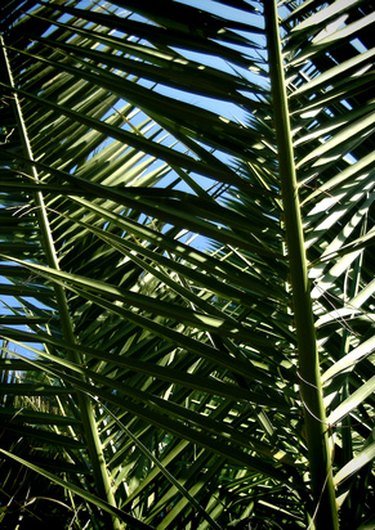
The pindo palm is a stout tree with a thick, rough trunk and long, feathery leaves. The pindo is more cold-hardy than some other palm trees. It is recognizable by its blue-gray palms that curve downward toward the textured trunk. The tree is known for its resistance to diseases and pests, but, like almost any living thing, it is susceptible to some problems.
Pythium and Phytophtora Root Rot
Video of the Day
Pythium and phytophtora are fungi that, if present in the soil around a pindo palm tree, can infect the tree through its roots. A tree is most susceptible when the moisture in the soil is very high. This typically happens during the spring or fall, when rain is more frequent and temperatures are cooler. The fungi enter the tree if spores are present in the moist soil, and they come into contact with the roots. Palm trees infected with pythium and phytophtora are affected gradually, from the ground up. The bases of the stems become discolored and smaller. The leaves begin to wilt, and the roots turn black and break off. The fungi are not treatable by fungicides, but you can prevent them from spreading to other trees. You should remove the infected pindo palm, and then replace it with nonsusceptible plants. Do not overwater the area, and remove and replace contaminated soil with sterilized soil mix.
Video of the Day
Rhizactonia Root and Stem Rot
Rhizactonia is a fungus found in many soils that can enter a pindo palm through the roots or the stem, at ground level. The infection can take hold when the soil is too saturated. During times of heavy rain and little direct sunshine, do not water the tree, and make sure the soil is well-drained. You can apply fungicide to a pindo palm with Rhizactonia to save the tree. You should always follow the directions on the fungicide container. The main symptom of the fungal disease is wilting leaves. If some of the leaves have not wilted, you can likely save the tree by removing dead foliage and treating with fungicide. If the tree is too far gone, you should remove it, and replace the soil around it with sterilized soil mixture.
Leaf Spots
Leaf spots are either fungal or bacterial diseases that grow on the pindo palm's foliage. An infected leaf develops brown or black spots with yellowish edges. The disease spreads through insects, dirty garden tools, rain and human contact. To help avoid infection, you should water the plant at the soil level, not on the foliage. During damp weather, after a rain, give the leaves a shake to avoid standing water on them. Use only clean garden tools, like pruning shears, and do not bring the tree into contact with another infected plant. Prune infected leaves when they are dry, and dispose of the leaves in a closed lawn bag to avoid spreading the disease.